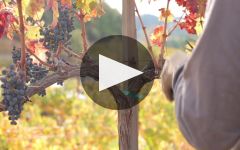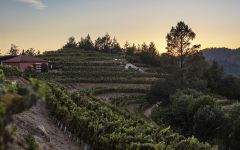Barnett Vineyards Rattlesnake Cabernet Sauvignon 2018
-
Connoisseurs'
Guide -
Wilfred
Wong -
Wine
Spectator -
Robert
Parker - Decanter
-
James
Suckling



Product Details
Your Rating
Somm Note
Winemaker Notes
The color of the wine is a beautiful dark purple at the core with a crimson rim. Immediate dark chocolate and coffee jump out of the glass, as well as blackcurrant puree and fresh blackberries. Underlying elements of eucalyptus, gravel, and pepper spice complement the licorice and nutmeg spice. This is a very lush velvety wine on entry. The dark berry fruit is very pronounced, with other flavors of peppercorn and mocha. The sizeable tannins are in a chalky complex form that is matched by the acidity and demand cellaring. This beautiful and substantial wine will age amazingly over the next 15-17 years (2035-2037).
Professional Ratings
-
Connoisseurs' Guide
Here is a wine that, from the very first sniff, is sure to make even the most hard-to-please Cabernet Sauvignon lovers sit up and take note. Its utterly gorgeous aromas of extraordinarily deep, beautifully defined, cassis-like fruit are overlain by lovely oak that brings a tantalizing touch of crèmebrûlée sweetness into play. While it is very solidly structured with the tannin's to age for years and years, its altogether unrelenting fruit effortlessly outdistances its youthful grip and astringency. It is a wine that serious collectors of fine Cabernet's who know the rewards of patience will not want to not miss, and bringing it to the table any sooner than a half-decade hence would, in our minds, be a near-unforgivable sin.
-
Wilfred Wong of Wine.com
COMMENTARY: The 2018 Barnett Vineyards Rattlesnake Cabernet Sauvignon is an outstanding example of Spring Mountain Cab. TASTING NOTES: This wine brings full and enticing aromas and flavors of ripe berries, plums, earth, and anise to the fore. Enjoy it with the first cut of a savory prime rib roast. (Tasted: December 18, 2020, San Francisco, CA)
-
Wine Spectator
Bright and lively, with a wide array of violet, sweet bay leaf and anise notes leading off, followed by a solid core of blackberry, boysenberry and plum paste flavors. Shows lots of energy through the finish, with a buried iron spine holding everything in place. Rock-solid. Best from 2022 through 2036.
-
Robert Parker's Wine Advocate
Deep garnet-purple colored, the 2018 Cabernet Sauvignon Rattlesnake opens a little broody with notes of crushed rocks, tar and tilled soil over a core over baked plums, warm cassis and mulberries. Medium to full-bodied, firm and grainy-textured, it delivers lovely freshness and an elegant, well-poised finish.
-
Decanter
Big intense cassis, with cedar, cloves, and coffee. Ripe rounded tannins, and a rich long finish. Wonderful poise, one for the long haul.
-
James Suckling
This shows ripe dark-fruit character with notes of licorice, cloves, leather and a touch of musk. Full-bodied and plush with a ripe-fruit core on the palate, chewy tannins and a long finish. This needs time for the tannins to soften.
Other Vintages
2021-
Robert
Parker -
James
Suckling
-
Robert
Parker
-
Wilfred
Wong -
Jeb
Dunnuck
-
Robert
Parker
-
Robert
Parker -
Wine
Spectator
-
Robert
Parker
-
Robert
Parker
-
Robert
Parker
-
Robert
Parker -
James
Suckling
-
Robert
Parker -
Wine
Enthusiast
-
Wine
Enthusiast -
Connoisseurs'
Guide -
Robert
Parker
-
Wine
Spectator

A noble variety bestowed with both power and concentration, Cabernet Sauvignon enjoys success all over the globe, its best examples showing potential to age beautifully for decades. Cabernet Sauvignon flourishes in Bordeaux's Medoc where it is often blended with Merlot and smaller amounts of some combination of Cabernet Franc, Malbecand Petit Verdot. In the Napa Valley, ‘Cab’ is responsible for some of the world’s most prestigious, age-worthy and sought-after “cult” wines. Somm Secret—DNA profiling in 1997 revealed that Cabernet Sauvignon was born from a spontaneous crossing of Cabernet Franc and Sauvignon Blanc in 17th century southwest France.

Above the town of St. Helena on the eastern slopes of the Mayacamas Mountains sits the Spring Mountain District.
A dynamic region, its vineyards, cut by numerous springs and streams, vary in elevation, slope and aspect. Soils differ throughout with over 20 distinct types inside of the 8,600 acres that define the appellation. Within that area, only about 1,000 are planted to vineyards. Predominantly farmed by small, independent producers, the region currently has just over 30 wineries.
During the growing season, late afternoon Pacific Ocean breezes reach the Spring Mountain vineyards, which sit at between 400 and 1,200 feet. Daytime temperatures during mid summer and early fall remain slightly cooler than those of the valley floor.
Spring Mountain soils—volcanic matter and sedimentary rock—create intense but balanced reds with lush and delicate tannins. The area excels with Bordeaux varieties such as Cabernet Sauvignon, Cabernet Franc and Merlot and in some cooler spots, Chardonnay.







